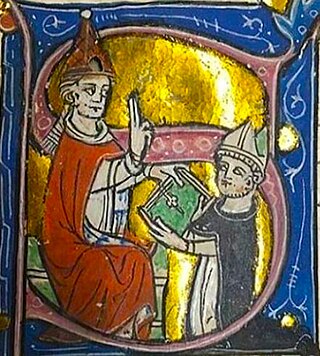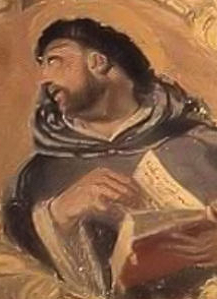Catharism was a Christian quasi-dualist or pseudo-Gnostic movement which thrived in Southern Europe, particularly in northern Italy and southern France, between the 12th and 14th centuries. Denounced as a heretical sect by the Catholic Church, its followers were attacked first by the Albigensian Crusade and later by the Medieval Inquisition, which eradicated the sect by 1350. Many thousands were slaughtered, hanged, or burnt at the stake, sometimes without regard for age or sex.

The Inquisition was a Catholic judicial procedure where the ecclesiastical judges could initiate, investigate and try cases in their jurisdiction. Popularly it became the name for various medieval and reformation-era State-organized tribunals whose aim was to combat heresy, apostasy, blasphemy, witchcraft, and other dangers, using this procedure. Studies of the records have found that the overwhelming majority of sentences consisted of penances, but convictions of unrepentant heresy were handed over to the secular courts for the application of local law, which generally resulted in execution or life imprisonment. If the accused was known to be lying, a single short application of non-maiming torture was allowed, to corroborate evidence.

The Medieval Inquisition was a series of Inquisitions from around 1184, including the Episcopal Inquisition (1184–1230s) and later the Papal Inquisition (1230s). The Medieval Inquisition was established in response to movements considered apostate or heretical to Roman Catholicism, in particular Catharism and Waldensians in Southern France and Northern Italy. These were the first movements of many inquisitions that would follow.

Pope Gregory IX was head of the Catholic Church and the ruler of the Papal States from 19 March 1227 until his death in 1241. He is known for issuing the Decretales and instituting the Papal Inquisition, in response to the failures of the episcopal inquisitions established during the time of Pope Lucius III, by means of the papal bull Ad abolendam, issued in 1184.

Konrad von Marburg was a medieval German Catholic priest, inquisitor and nobleman. He is perhaps best known as the spiritual director of Elizabeth of Hungary.

Bernard Gui, also known as Bernardo Gui or Bernardus Guidonis, was a Limousin Dominican friar, Bishop of Lodève, and a papal inquisitor during the later stages of the Medieval Inquisition.
Conrad, called the Red, was Duke of Lorraine from 944 until 953. He became the progenitor of the Imperial Salian dynasty.

Sayn was a small German county of the Holy Roman Empire which, during the Middle Ages, existed within what is today Rheinland-Pfalz.
Henry III "the Great" was the count of Sayn (1202–1246), a county located near the Sieg River in northern Rhineland-Palatinate, Germany. Henry III shared the first year of his reign with his uncle, count Henry II, as he and his father Eberhard II had co-ruled the county. Gottfried II had been a regent from 1181 and continued until his death in 1220. John, count of Sponheim-Starkenburg, was regent from 1226 until Henry's death in 1246.

The Directorium Inquisitorum is Nicholas Eymerich's most prominent and enduring work, written in Latin and consisting of approximately 800 pages, which he had composed as early as 1376. Eymerich had written an earlier treatise on sorcery, perhaps as early as 1359, which he extensively reworked into the Directorium Inqusitorum. In compiling the book, Eymerich used many of the magic texts he had previously confiscated from accused sorcerers. It can also be considered as an assessment of a century and a half of official Inquisition in the "albigensian" country.
Raymond du Fauga was a French Dominican, and bishop of Toulouse from 1232 to 1270. He was a significant figure in the struggle in Languedoc between the Catholic Church and the Cathars.
Vox in Rama is a decretal sent by Pope Gregory IX in June 1233 condemning the heresy of Luciferianism said to be rife in Germany, and authorizing the preaching of a crusade against it. Copies of the letter were sent to Emperor Frederick II, King Henry (VII) of Germany, Archbishop Siegfried III of Mainz, his suffragans, Bishop Conrad II of Hildesheim and the preacher Konrad von Marburg. The copies are dated to 11, 13 and 14 June.

Bernard Délicieux was a Spiritual Franciscan friar who resisted the Inquisition in Carcassonne and Languedoc region of southern France.
The Bosnian Crusade was fought against unspecified heretics from 1235 to 1241 and was essentially a Hungarian war of conquest against the Banate of Bosnia that was sanctioned as a crusade. Led by a Hungarian prince, Coloman, the crusaders succeeded in conquering only peripheral parts of the country. They were followed by Dominicans, who erected a cathedral and put heretics to death by burning.

The Stedinger Crusade (1233–1234) was a Papally sanctioned war against the rebellious peasants of Stedingen.
The Chronicon Wormatiense is a fragmentary anonymous Latin chronicle of the city of Worms, Germany. It was probably composed in the last quarter of the 13th century. There is an English translation by David Bachrach.

William Arnaud or Guillaume Arnaud was a Dominican inquisitor and martyr.
The German Inquisition was established by Pope Gregory IX in 1231, and the first inquisitor was appointed in the territory of Germany. In the second half of the 14th century, permanent structures of the Inquisition were organized in Germany, which, with the exception of one tribunal, survived only until the time of the Reformation in the first half of the 16th century. In combating heretics in Germany, the Inquisition always played a secondary role compared to the ecclesiastical courts.
France was one of the first countries where the papal inquisition was established in the 13th century. This ecclesiastical judicial institution was created to combat heresies. The southern region of France, Languedoc, was the primary center of inquisition activity in Europe until the mid-14th century. Most of the preserved sources concerning the inquisition originate from this region. However, the history of the French Inquisition spans until the end of the 17th century and also encompasses other areas of the country.
The history of the inquisition in the Czech lands spans nearly two and a half centuries, beginning in 1257. However, it can be said to have functioned consistently for only about 100 years, from around 1315/1318 to around 1415. This church institution, established to combat heresies, took on a rather specific form in this country, as from the mid-14th century it was placed under the direct control of the Archbishop of Prague, whereas the norm was for the Inquisition to be subordinated solely to the Holy See.